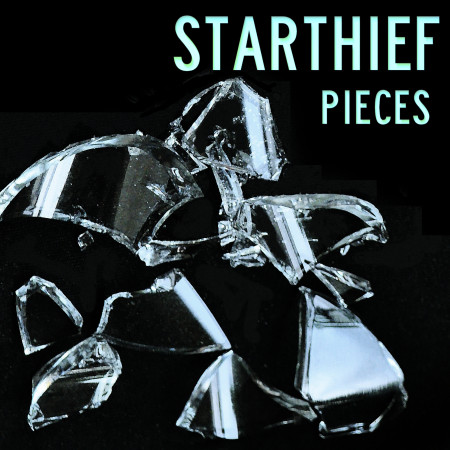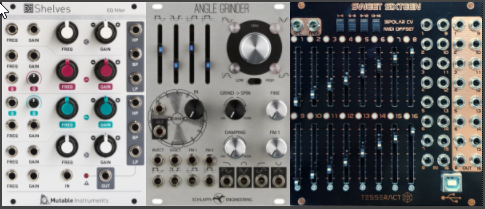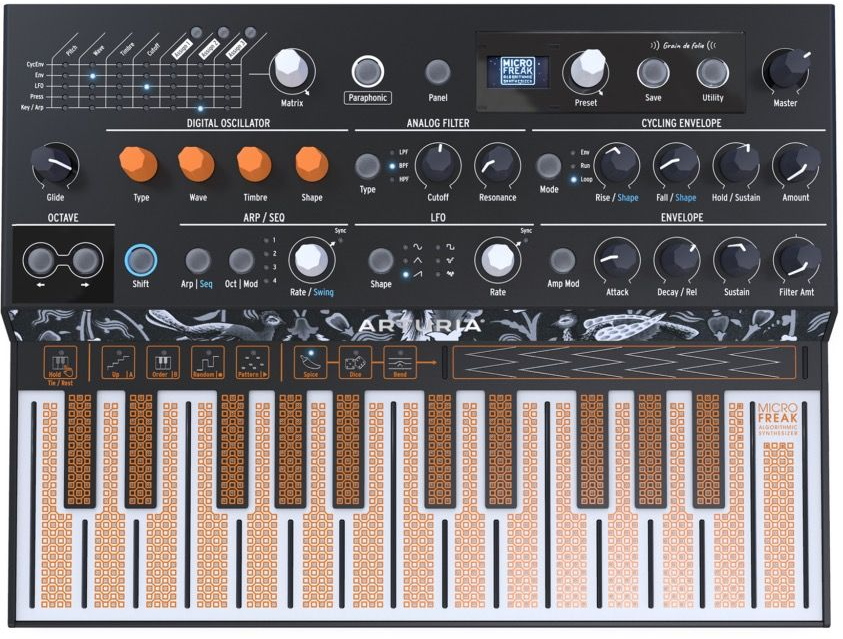
After recording four pieces of music at the start of this project, I noticed that, without especially intending to do so in advance, I restricted each of them to just one or two voices.
“Voices” can be something of a loaded word with this music, just as some people insist that you can’t call a piece of music a “song” unless there’s a singer, Mendelssohn be damned. What I refer to as a “voice” is typically the sound that goes into its own mixer channel in the DAW, distinct (to at least some extent) from other voices in terms of timbre and parts played. This of course invites looking at the term “track”, which refers to a division of media or the production process either serially (“third track on the CD”) or parallel-wise (“four-track tape deck,” “click track” etc.) And of course the word “piece” makes one consider a musical work as a fragment of something rather than as a whole in itself, which I find particularly fitting since I greatly prefer albums to singles.
Anyway! I decided I’d record a full album with similar pieces, not minimalist in sound but consisting of less than three voices. I was successful by means of questionable accounting — sometimes I had a little extra sub-voice under separate mix control, intended to blend and support with full voices, without its own musical phrasing or distinct timbre.
Throughout the Album
Pieces was recorded with a Eurorack modular synthesizer, a Polyend+Dreadbox Medusa, Arturia Microfreak, and Bitwig Studio with several software plugins.




I don’t keep detailed notes about utility modules, EQ or noise gate plugins, etc. unless used in a distinctive way.
My process was outlined in the patch notes for Carefully Introducing Problems, so I won’t repeat that here. I’ve added the recently released Voxengo TEOTE to my mastering chain.
01 All Candles Be Out
The drone is the Intellijel Shapeshifter, processed by Schlappi Engineering Angle Grinder, Mutable Instruments Shelves, and Native Instruments Raum reverb and Supercharger GT saturation/compressor.
The melodic part is the Medusa, through Valhalla Delay, u-he Runciter, my own Potty Mouth “hacked chorus” plugin, d16 Fazortan, and Valhalla Plate.
02 Transitional Series
The main voice here is the Medusa, using its powerful touch grid sequencer with parameter locks, processed by Valhalla Room, d16 Syntorus, AudioThing Speakers, and Wavesfactory Cassette.
The bass drone is from the Microfreak, with XLN Audio RC-20 Retro Color.
03 Cinerous
The 4ms Ensemble Oscillator (“ENOSC”) through Mutable Instruments Rings, along with a Phonogene recording of same. They are mixed in Mutable Instruments Blinds, and processed with some LFO-modulated CraveEQ as well as Valhalla Room.
04 Phosphorescent Waves
The chords are from ALM Busy Circuits Akemie’s Castle through Sugar Bytes WOW 2, u-he Runciter, Valhalla Supermassive, and Supercharger GT. The pitch and the multiplier for Operator 1 are sequenced by Monome Teletype triggers attenuated in Mutable Instruments Blinds.
Blended with that is a sub-bass drone from Angle Grinder, through Runciter and AudioThing Speakers.
The sequenced melody is ENOSC through Rabid Elephant Natural Gate, Mutable Instruments Beads, and Happy Nerding FX Aid (highpass delay algorithm). The sequence is from the Make Noise 0-Ctrl, clocked by the Teletype with the clock multiplied by an LFO segment in Mutable Instruments Stages.
05 Friction
The first voice is the Microfreak, processed by Freakshow Industries Mishby, Plogue Chipcrusher, and Wavesfactory Echo Cat.
The second is Intellijel Shapeshifter, DigDugDIY Purple Rain, Mutable Instruments Shelves, Synthesis Technology E520 (Spectral Delay algo), Audio Damage Rough Rider and Valhalla Supermassive.
The full mix has additional reverb from Valhalla Room.
06 From the Ceiling to the Floor
This is Mutable Instruments Rings in sympathetic string mode, with its Even output self-patched into its Strum input, and the Structure sequenced by Marbles. Through E520 (Spectral Crusher algorithm), a complex rectifier patch in Bitwig Grid, and Native Instruments Raum reverb.
07 Stop for Breath
The first voice is ENOSC sequenced by Marbles, through a feedback loop with WMD MSCL compressor and FX Aid (Infinite Dark reverb algo), with Echo Cat and RC-20.
The second is a looped sample of the Microfreak through Echo Cat, further processed by Bitwig Delay1 with Audio Damage Ratshack Reverb in its feedback loop and two Bitwig pitch shifters.
A pair of field recordings were softly layered below the mix, blending with Echo Cat’s simulated tape noise.
08 Black Door
The drone is Akemie’s Castle and Shapeshifter, mixed in u-he CVilization (quad panner mode). In Bitwig Grid, two of CVz’s outputs run through a mild highpass filter, while the other two through a short delay and a lowpass filter, and are mixed in simulated quadraphonic sound. Some Native Instruments Raum reverb.
The noise is Shapeshifter’s pulse output through Random*Source Serge VCFQ into Phonogene, with Echo Cat, LFO-modulated CraveEQ, Valhalla Delay and Speakers.
09 Machines of IX
The first voice is Akemie’s Castle output B processed by MSCL, Supercharger GT, and Supermassive; blended with it is output A, highpass filtered in Angle Grinder, with E520 (Spectral Crusher) and Valhalla Delay.
Voice 2 is Beads (acting as an oscillator) through Natural Gate, through FX Aid (Infinite Dark reverb).
Sequencing/modulation was from 0-Ctrl, The Harvestman Zorlon Cannon, and Make Noise Maths.
10 Energy Exchange
A feedback loop with Make Noise Mimeophon and Beads, using CVilization as a matrix mixer. As once voice it runs through Phonogene, a Bitwig Grid comb filter, Supermassive and Bitwig Transient Control; as a second it runs through Echo Cat. The full mix is through Runciter and Valhalla Vintage Verb.
11 Awaken Carefully
The first voice is VCFQ pings processed by Rings and Beads, mixed with the raw pings, through Echo Cat.
The second voice is ENOSC through Shelves and Angle Grinder bandpass filters, Mimeophon, E520 (Diffusion Flanger algo), Valhalla Delay, and Raum (on just higher frequencies).
Sequencing is from the 0-Ctrl processed by CVilization’s Mucorder mode.
The mix was recorded with a lot of noise from Echo Cat, boosted by compression — and then processed with Sound Forge noise reduction, Melda MSpectralDelay to reduce the noise further and soften the attacks, and then Supermassive.
12 Eidolon
The main voice is Medusa through two mixed FX chains: (A) is FX Aid (oil can delay algo), Beads, MSCL and Noveltech Character, and (B) is Arturia Plate-140.
Accompanying it is the Microfreak through Bitwig pitch shifter and Valhalla Room.
